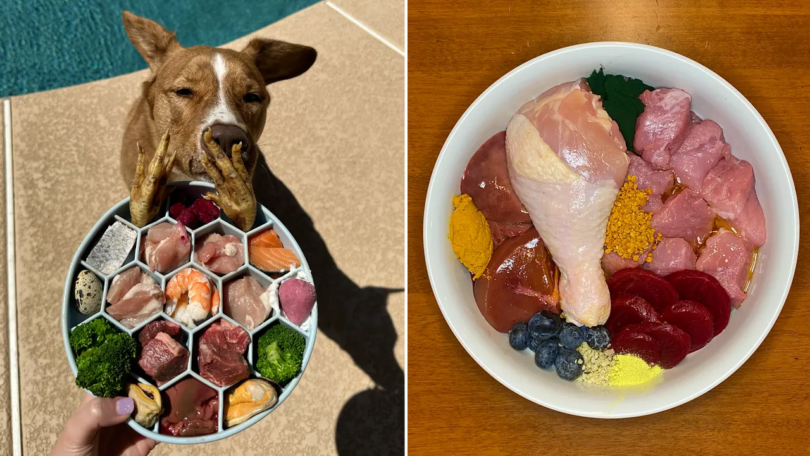As a devoted pet owner, you're always looking for ways to improve your furry friend's health and well-being. One increasingly popular option is switching to a raw dog food diet. This natural approach to feeding mimics what dogs would eat in the wild and can offer numerous benefits for your pet's overall health. In this comprehensive guide, we'll explore the top 10 benefits of switching to a raw dog food diet and how it can positively impact your dog's life.
1. Improved Digestive Health
One of the most significant benefits of a raw dog food diet is the positive impact on your pet's digestive system.
Natural Enzymes
Raw food contains natural enzymes that aid in digestion. These enzymes are often destroyed during the cooking process of commercial dog foods, making it harder for your dog to break down and absorb nutrients.
Reduced Digestive Issues
Many dog owners report a decrease in common digestive problems such as:
- Gas
- Bloating
- Diarrhea
- Constipation
Smaller, Firmer Stools
Raw diets typically result in smaller, firmer stools due to better nutrient absorption. This can make clean-up easier and indicate that your dog is utilizing more of what they eat.
2. Enhanced Dental Health
Maintaining good dental health is crucial for your dog's overall well-being, and a raw diet can play a significant role in this area.
Natural Teeth Cleaning
Chewing on raw meaty bones acts as a natural toothbrush, helping to remove plaque and tartar buildup.
Reduced Bad Breath
Many dog owners notice a significant improvement in their pet's breath after switching to a raw diet. This is often due to the reduction in tartar and the absence of processed ingredients that can contribute to bad breath.
Stronger Jaw Muscles
The act of chewing raw meat and bones helps to strengthen your dog's jaw muscles, promoting overall oral health.
3. Healthier Skin and Coat
A raw diet can have a remarkable impact on your dog's skin and coat health.
Increased Omega-3 Fatty Acids
Raw diets often include sources of omega-3 fatty acids, such as fish or flaxseed, which contribute to a shiny, healthy coat.
Reduced Allergies and Skin Irritations
Many dogs with skin allergies or irritations see improvement after switching to a raw diet. This may be due to the elimination of common allergens found in processed dog foods.
Natural Oils
Raw food helps maintain the natural oils in your dog's skin and coat, leading to a softer, more lustrous appearance.
4. Increased Energy Levels
Many pet owners report a noticeable increase in their dog's energy levels after switching to a raw diet.
Better Nutrient Absorption
The high-quality, easily digestible proteins in raw food provide sustained energy throughout the day.
Balanced Energy
Unlike the energy spikes and crashes often associated with high-carbohydrate commercial diets, raw diets provide a more balanced, consistent energy level.
Improved Stamina
Dogs on raw diets often exhibit improved stamina during physical activities and play.
5. Stronger Immune System
A raw diet can significantly boost your dog's immune system, leading to better overall health.
Natural Antioxidants
Raw fruits and vegetables provide natural antioxidants that help fight free radicals and support immune function.
Reduced Inflammation
The absence of processed ingredients and the inclusion of natural anti-inflammatory foods can help reduce overall inflammation in the body.
Balanced Gut Microbiome
A healthy gut is crucial for a strong immune system. Raw diets promote a balanced gut microbiome, which is essential for optimal immune function.
6. Weight Management
Maintaining a healthy weight is easier with a raw dog food diet.
High Protein, Low Carbohydrate
Raw diets are typically high in protein and low in carbohydrates, which can help dogs maintain a healthy weight more easily.
Increased Satiety
The high protein content in raw diets helps dogs feel fuller for longer, reducing the likelihood of overeating.
Muscle Maintenance
The quality proteins in raw diets support muscle maintenance, which is crucial for maintaining a healthy metabolism.
7. Improved Bone and Joint Health
Raw diets can have a positive impact on your dog's bone and joint health.
Natural Calcium Sources
Raw meaty bones provide a natural source of calcium, essential for strong bones and teeth.
Balanced Phosphorus Levels
Raw diets often have a better calcium-to-phosphorus ratio, which is crucial for proper bone development and maintenance.
Reduced Inflammation
The anti-inflammatory properties of many raw diet ingredients can help alleviate joint pain and stiffness, particularly in older dogs or those with arthritis.
8. Better Hydration
Proper hydration is essential for your dog's health, and a raw diet can contribute to better hydration levels.
Higher Moisture Content
Raw food typically has a higher moisture content than dry kibble, helping to keep your dog hydrated.
Increased Water Intake
Many dogs on raw diets naturally drink more water, further supporting proper hydration.
Improved Kidney Function
Better hydration can lead to improved kidney function and a reduced risk of urinary tract issues.
9. Enhanced Mental Stimulation
Feeding a raw diet can provide mental stimulation for your dog, contributing to their overall well-being.
Natural Chewing Behavior
Chewing on raw meaty bones satisfies your dog's natural instincts and provides mental stimulation.
Varied Diet
The variety of ingredients in a raw diet can keep mealtime interesting for your dog, providing mental engagement.
Food Puzzle Opportunities
Raw diets lend themselves well to food puzzles and interactive feeding methods, further enhancing mental stimulation.
10. Reduced Allergies and Sensitivities
Many dogs experience a reduction in allergies and food sensitivities when switched to a raw diet.
Elimination of Common Allergens
Raw diets often eliminate common allergens found in commercial dog foods, such as wheat, corn, and soy.
Identifiable Ingredients
With a raw diet, you have complete control over the ingredients, making it easier to identify and avoid potential allergens.
Improved Gut Health
A healthier gut, promoted by a raw diet, can lead to a reduction in food sensitivities and allergic reactions.
Transitioning to a Raw Dog Food Diet
While the benefits of a raw dog food diet are numerous, it's essential to transition your pet carefully and responsibly.
Gradual Introduction
Start by introducing small amounts of raw food alongside your dog's current diet, gradually increasing the proportion over time.
Variety is Key
Ensure your dog receives a variety of proteins, organs, bones, fruits, and vegetables to provide a balanced diet.
Consult Your Veterinarian
Always consult with your veterinarian before making significant changes to your dog's diet, especially if your pet has existing health conditions.
Safe Handling Practices
Practice safe food handling when preparing raw meals to prevent the risk of bacterial contamination.
Common Concerns and Misconceptions
Bacterial Contamination
While there is a risk of bacterial contamination with raw food, proper handling and storage practices can minimize this risk. Dogs' digestive systems are also better equipped to handle raw meat than humans.
Nutritional Balance
Some worry that raw diets may not provide balanced nutrition. However, with proper research and guidance, it's possible to create a well-balanced raw diet that meets all of your dog's nutritional needs.
Cost
While raw diets can be more expensive than commercial kibble, many pet owners find the health benefits outweigh the additional cost. There are also ways to make raw feeding more cost-effective, such as buying in bulk or preparing meals at home. Switching to a raw dog food diet can offer numerous benefits for your pet's health, from improved digestion and dental health to enhanced energy levels and a stronger immune system.
While it requires careful planning and preparation, many dog owners find that the positive changes in their pet's overall well-being make the transition worthwhile. As with any significant dietary change, it's essential to consult with your veterinarian and do thorough research to ensure you're providing the best possible nutrition for your furry friend.











Leave a Comment